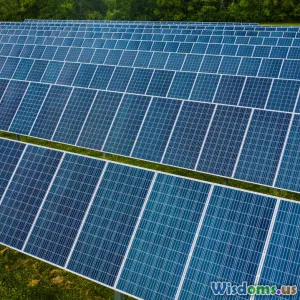
The Hidden Costs of Traditional Power Versus Renewables
17 min read Explore the often-overlooked economic and environmental costs of traditional power compared to renewable energy solutions. (0 Reviews)
The Hidden Costs of Traditional Power Versus Renewables
Amid accelerating climate change and mounting energy bills, the debate between traditional power sources and renewables continues to escalate. While the up-front sticker price of electricity—how much your utility charges you per kilowatt-hour—garners attention, this only tells a fragment of the economic story. Beneath the surface lie enormous, often invisible, expenses—what economists call externalities—that can sway the balance in profound, sometimes surprising ways. Understanding these hidden costs can transform how businesses, governments, and individuals make energy decisions, reframing affordability, responsibility, and sustainability. Let's unpack what truly distinguishes traditional power from renewables when considering the price the world actually pays.
Unmasking Externalities: More Than Meets the Eye

When electricity is generated by burning fossil fuels like coal, oil, or natural gas, the financial transaction seems straightforward: investments in plant construction, machinery maintenance, fuel purchasing, and labor culminate in the utility's billed costs. Yet these figures neglect critical "externalities"—costs not shouldered by the producer or consumer but by society at large. These include air and water pollution, long-term health impacts, ecosystem degradation, and climate change acceleration.
A study by the International Monetary Fund (IMF) estimated that global fossil-fuel subsidies, largely in the form of unpriced externalities, reached $5.9 trillion in 2020. For example, particulate emissions from coal-fired plants contribute not just to smog but also to premature deaths, asthma in children, and chronic diseases—costs the health system, not power plants, must absorb. The U.S. National Academy of Sciences found that air pollution from coal combustion costs Americans over $62 billion annually in health damages alone.
These societal expenses constitute a hidden tax. By contrast, when solar panels generate electricity, they produce almost no emissions, and as such, their externalities are minimal. This fundamental disparity in downstream impacts is too consequential to ignore.
Infrastructure Footprints: Building for Now Versus the Future

Traditional power plants require enormous upfront investments and long-term commitments. Large-scale coal or natural gas facilities typically entail not just the central generation complex but miles of dedicated transmission lines, fuel transportation infrastructure (railways, pipelines), and substantial water for cooling systems. The average lifespan of a coal plant is 30-50 years; closing one early leaves behind stranded assets and environmental remediation bills.
Renewable infrastructure comes with its costs too, but often with critical differences in scale, modularity, and decommissioning. For example:
- Solar and wind farms can be constructed faster and modularly expanded. Their distributed nature allows placement near load centers (cities), reducing the length—and hence costs—of transmission lines.
- Decommissioning: Retiring a wind turbine or solar panel is cheaper and safer than decommissioning a nuclear plant or a coal ash lagoon, which might require decades and billions for cleanup.
Moreover, renewables are increasingly paired with battery storage or "smart grid" investments, both of which future-proof infrastructure with flexibility and resilience against blackouts. A prominent example is the South Australian Hornsdale Power Reserve, where Tesla batteries buffer the grid, providing rapid-response backup where fossil generators would struggle.
Water Use and Scarcity: A Critical but Overlooked Cost

One of the least appreciated distinctions between traditional and renewable power sources is their relationship with water. Thermal power plants—including coal, gas, and especially nuclear—rely heavily on water for cooling.
Consider that the average coal-fired power plant may withdraw up to 8,000 liters of water per megawatt-hour of electricity. In water-stressed states like California or parts of Texas, this puts electricity production in direct competition with agriculture, cities, and ecosystems, especially amid ongoing megadroughts.
By contrast, the operation of solar photovoltaic and wind energy requires negligible water. Hydroelectric plants are an exception, but innovative run-of-the-river designs or floating solar arrays on reservoirs can help reduce environmental impacts. In times when water is rapidly becoming the world's scarcest commodity, power systems that conserve—rather than consume—water could very well be invaluable.
Climate Costs: The Price of Carbon Pollution

Carbon dioxide (CO₂) released from burning fossil fuels is the leading human contributor to climate change. This causes more frequent and severe wildfires, hurricanes, droughts, and heatwaves—phenomena with mounting economic impacts. For example, the U.S. saw $120 billion in climate disaster damages in 2022 alone, with over 25 events surpassing $1 billion each, according to NOAA.
Economists assign a dollar figure to these effects, known as the "social cost of carbon". As of 2023, the U.S. government uses $51 per metric ton of CO₂ as a baseline estimate for climate-related harms such as degraded agricultural yields, flood damages, and health effects. If the real societal costs of carbon were directly included in electricity prices, fossil power would not appear nearly as cheap as it does today.
Renewable sources like wind and solar generate electricity nearly carbon-free, representing by far the lowest current and future climate-related liabilities. In effect, choosing renewables is a proactive measure to avoid massive deferred costs borne by taxpayers, businesses, and communities
The Reality of Intermittency: What's the True System Cost?

A common critique of renewables is their intermittency—wind doesn’t always blow, and the sun doesn’t always shine. While this introduces new planning and integration challenges, improvements in grid management, storage technologies, and demand response strategies have made these challenges far more surmountable than once imagined.
Today's grid operators have demonstrated (not just modeled) that high penetrations of renewables are feasible. Denmark, for instance, routinely sources more than half of its electricity from wind, with sophisticated forecasting and flexible cross-border grid connections. In the U.S., California hit over 100% renewable grid coverage for short intervals in 2022.
Battery costs have fallen over 80% since 2010, and innovative projects are now storing surplus power for hours or even days, slashing the need for fossil fuel backup. As storage becomes more financially competitive, renewable integration's net system costs—including backup and grid reforms—are shrinking, recasting intermittency as an addressable rather than insurmountable hurdle.
Hidden Subsidies: Unpacking Fair Play in the Market

One frequently cited argument against renewables is their dependence on subsidies and policy incentives like tax credits or feed-in tariffs. While subsidies undoubtedly spurred early adoption, their magnitude pales beside the long, often-invisible support mechanisms enjoyed by fossil fuels.
Fossil fuels benefit from a web of subsidies: tax code loopholes, public land leases at below-market rates, royalty exemptions, depletion allowances, and, perhaps most significantly, the ability to externalize huge environmental and health costs on the public. One analysis estimated that the effective support for fossil fuels in G20 countries topped $440 billion in 2022—far outweighing global incentives for renewables in many regions.
In fact, if market rules adjusted to internalize environmental damage (for example, through a carbon tax or trading system), renewables' unsubsidized competitiveness would rise sharply, even without extra government help. Equity and transparency in energy markets demand acknowledging and rebalancing these historical biases.
Reliability and Resilience: Comparing Outage Risks

A robust electric grid must remain dependable even during storms, extreme heat, or cyberattacks. While base-load fossil plants have long underpinned grid stability, recent trends highlight vulnerability rather than invincibility. Massive blackouts—from Texas’s winter storm Uri in 2021 to California wildfire-driven shutoffs—have been traced, ironically, to the failure or unavailability of fossil-fueled generators and antiquated grid components.
Conversely, distributed renewable systems, microgrids, and battery-backed installations are increasingly used to shore up reliability. Even large data centers and military bases now rely on on-site solar plus storage to maintain critical functions if the main grid falters. The rise of community solar gardens and virtual power plants exemplifies a move toward "grid democratization"—empowering neighborhoods to produce and manage their energy, increasing local resilience to disruptions beyond their control.
Health Impact Accounting: Human Lives in the Ledger

Every year, millions are exposed to air and water pollutants from burning coal, oil, and gas. The World Health Organization reports that air pollution accounts for around 7 million premature deaths annually, with a hefty share attributable to power generation.
Asthma rates in children, cardiovascular disease in adults, and expensive emergency room visits are indirect consequences of traditional power deployment. Residents living near coal-fired plants, for example, face increased cancer risks due to mercury and heavy metal contamination.
A 2019 Harvard study calculated that switching from coal to renewables in the U.S. could save approximately 50,000 lives per year and billions in medical costs. These are not abstract statistics; they're workplace absences, lost productivity, and devastating human stories—costs that renewable energy can dramatically reduce by design.
Waste Management: Who Pays for Cleanup?

Traditional power isn't only about burning fuel—it's about managing hazardous remains. Coal combustion produces more than 100 million tons of ash waste in the U.S. alone, requiring safe disposal to avoid toxic leaching into groundwater.
Nuclear power presents its own long-term challenge: spent fuel rods that stay radioactive for centuries or millennia. After decades of use, the U.S. still lacks a consensus solution for permanent nuclear waste storage, leading to expensive, temporary holding facilities that demand intensive regulation and oversight.
Renewables bring their own end-of-life hurdles—like recycling decommissioned solar panels or turbine blades—but innovations are already enabling higher recovery rates of valuable materials. With the correct regulatory approaches and emerging recycling industries, the life-cycle waste footprint of renewables can be kept modest and manageable, especially compared to the complex, perilous legacies of fossil and nuclear waste.
Jobs and Economic Opportunity: The Cost of Transition

Critics sometimes claim that a move away from fossil fuels will devastate local economies, stripping mining and drilling regions of their livelihoods. While transitions are indeed disruptive and require careful anticipation, data increasingly suggests that renewables deliver not just new jobs, but higher-quality, safer ones.
A 2022 report by the International Renewable Energy Agency (IRENA) found the sector supports more than 12 million jobs globally, a number growing rapidly as deployment rises. Solar and wind installation/maintenance jobs outpace those lost to coal in many regions, and studies indicate that renewable energy investments generate nearly three times more jobs per dollar compared with fossil-fuel equivalents.
Thoughtful policy that funds retraining, local ownership, and community engagement is key. For instance, Colorado’s "Just Transition" program helps coal workers move directly into renewables—showing how costs can be socialized nor avoided, opening new paths for inclusive economic growth.
The Bottom Line: Shifting Perspective for Smarter Decisions

Peeling back the layers of energy economics reveals a baseline reality: the apparent affordability of fossil energy hinges on making someone else (often the public or future generations) foot the bill. The actual cost landscape includes not just fuel and infrastructure, but health, nature, safety, and societal well-being.
As policy, technology, and markets evolve, embracing renewables is not simply an environmental imperative—it’s a pragmatic economic strategy that acknowledges the true, fully loaded price tag of powering civilizations. Savvy investors, community leaders, and everyday consumers increasingly recognize that the future belongs to those who see and act on the full picture—choosing solutions with long-term gains, not merely short-term savings.
Rate the Post
User Reviews
Popular Posts



















